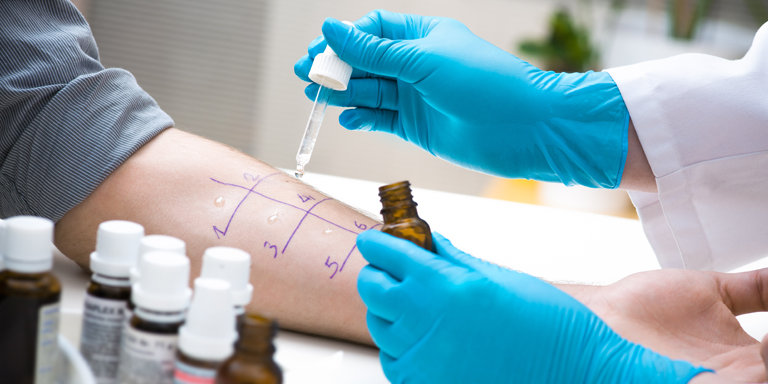Drugs: allergies and intolerances
Although adverse drug reactions are common, they are only sometimes due to allergy or intolerance.

Table of contents:
Adverse reactions are relatively common when taking drugs. It is often initially assumed that they are an allergic reaction. However, a drug allergy where the immune system mistakenly identifies an ingredient as foreign and has a reaction to it occurs only rarely.
Triggers
A distinction is drawn between two different forms of adverse drug reaction:
- predictable, typical reactions due to the normal mechanism of action of the drug (undesirable effects)
- unpredictable reactions (intolerances)
- triggered by immunological mechanisms (allergy)
- triggered by non-immunological mechanisms (intolerance, pseudoallergy)
Symptoms
Typical adverse drug reactions
Adverse reactions are mostly caused by ingredients of drugs and are thus already known and stated in the package leaflet. The course is usually mild and they rapidly abate.
Drug allergy
The allergic reaction may be either immediate, with symptoms showing within a few minutes of taking a drug, or delayed, with symptoms often first occurring after several days or weeks.
Immediate allergic reactions
- reddening of the skin
- hives (urticaria)
- swelling of the skin and mucous membranes (angioedema)
- cold-like symptoms (rhinitis)
- respiratory and cardiovascular symptoms
- anaphylaxis presenting with more than one of the above symptoms
Delayed allergic reactions
- measles-like, very itchy rash, sometimes with blistering on the skin
- painful reddening and bleeding of the skin, triggered by, for example, inflammation of the smallest blood vessels of the skin or mucous membrane
- in severe forms, involvement of the internal organs, especially the liver (hepatitis), lungs, heart and kidneys, usually associated with feeling unwell, fever and fatigue, which are sometimes considered indicative of a flare-up of an underlying disease and not of an allergic reaction.
Drug intolerance
Although cells of the immune system are also often involved in non-immunological reactions (or intolerances), the immune system does not identify the drug as foreign, as is the case with drug allergy. Instead, they are directly activated by other mechanisms. At first sight, the symptoms of an intolerance are very similar to those of an allergy, hence the term “pseudoallergy”. Examination by an allergy specialist is required to confirm the diagnosis.
Pain-killer intolerance
Traditional pain-killers such as aspirin, ibuprofen, diclofenac and mefenamic acid can trigger non-immunological reactions. On taking pain-killers, sufferers have adverse reactions similar to the immediate adverse reactions as described above.
ACE inhibitor intolerance
ACE inhibitors are a class of drugs used to treat high blood pressure (antihypertensives, such as lisinopril and enalapril), which can trigger both irritation of the throat and swelling of the skin or mucous membranes as adverse reactions.
Contrast media intolerance
In rare cases, i.e. in 1 to 30,000 to 50,000 applications, contrast media, such as are used in x-ray examinations, can trigger adverse reactions. This is very commonly associated with the high salt content and the rapid infusion of sometimes high amounts of contrast media. In individual cases, a true drug allergy is demonstrated, and it is for this very reason that with more severe reactions examination by an allergy specialist is recommended.
Local anaesthetics
Local anaesthetics, which act in the immediate area of the injection site, such as in dental surgery, can result in an intolerance reaction. Reported symptoms include palpitations and increased blood pressure as well as tremor, headache, anxiety and hyperventilation. An allergy is a rare exception. The reaction is often due to the anaesthetic being mistakenly injected directly into the bloodstream. The effect of the local anaesthetic is therefore not just local, as the anaesthetic is transported throughout the body. This results in cardiac arrhythmia and circulatory disorders.
Phototoxic and photoallergic reactions
In phototoxic reactions, chemical or natural compounds in drugs, perfume and cosmetics interact with skin cells under the sun’s ultraviolet rays. With a photoallergic reaction, it is not the sun itself that is the allergy trigger but a substance that comes into contact with the skin either from inside or outside the body and the structure of which changes on exposure to the sun.
Diagnosis
Anyone who notices any unusual side effects or is unsure about them should not hesitate to contact their doctor and, where appropriate, undergo an examination by an allergy specialist.
It is helpful to make a note of the symptoms and any medication taken beforehand (including non-prescription and herbal medicines). Sufferers should also note down the order in which symptoms occur. A photograph of any acute skin reactions can also be helpful.
The first step, in consultation with the treating doctor, is to stop taking the suspected drug. With very severe reactions, all medicines should be stopped, even those that have not triggered any reactions before, until the symptoms abate.
The decision as to whether the patient should strictly avoid a drug or one specific class of active substance in future should, however, not be based on just the symptoms as presented but on detailed diagnostic information.
The tests should be performed at least four to eight weeks after the reaction, as the cells involved in the reaction take some time to recover. If performed too early, there will be no reaction and the test results can lead to false conclusions. The most reliable test results are thus achieved six weeks to six months after the symptoms have abated.
Risk factors
An allergy or intolerance to a drug is hard to predict. Anyone can experience unpredictable adverse reactions from a drug and there is no way of knowing who is especially at risk.
Drug allergy
Those over 50 with a heart condition are at particular risk of a severe course of drug allergy (especially with beta lactam antibiotics, muscle relaxants and x-ray contrast media). Moreover, certain classes of drug are more likely to cause allergic reactions. This is especially the case with:
- antibiotics (e.g. penicillin)
- gout medication (e.g. allopurinol)
- antiepileptics
- pain-killers (e.g. aspirin)
Drug intolerance
Those with severe asthma or urticaria (hives) are particularly prone to tolerate pain-killers poorly due to their mechanism of action. But this is not an allergy but an intolerance, which can, however, be similarly severe.
Treatment
For typical adverse reactions
If typical adverse drug reactions persist, a doctor should be consulted to determine the steps to be taken. Sometimes it is enough to reduce the dose, where possible, or to switch to another drug. If this is not possible, or the desired effect is not achieved, mild, non-allergic adverse reactions such as nausea or pain are treated with a further drug, where required. This allows the treatment to be continued.
Drug allergy and intolerance
Antihistamines or cortisones are often used to treat any reactions that occur. Anaphylaxis sufferers should always have an emergency kit at hand prescribed by their doctor. The emergency kit comprises one or two prefilled adrenaline syringes and an antihistamine and cortisone product in either tablet or drop form and possibly an asthma spray as well. The doctor will determine the dosage and use of each medicine. Both sufferers and their parents or carers should know and regularly practise how to use the kit in emergencies. For more safety in everyday life, the aha! Swiss Allergy Centre provides anaphylaxis training courses for those with severe allergic reactions and their relatives.
Desensitisation
Desensitisation is mostly used for drugs that are considered essential and for which no alternative is available. It has been particularly effective with cancer drugs and antibiotics such as penicillin. Desensitisation is also used for non-immunological reactions to pain-killers.
Prevention of new reactions
Reliable diagnosis is essential, as the most effective preventive measure is to avoid the drug triggering the reaction in future. To this end, sufferers are issued with an emergency allergy card by their doctor, giving the type of reaction, the triggers, any cross-reactive substances and alternative medication that is tolerated. They should always have the emergency allergy card with them and the treating doctor, dentist or pharmacist must always be informed of the drug allergy or intolerance when consulted.
Facts and figures
Adverse reactions to drugs are relatively common. It is thought that approximately 15% of patients in hospital and overall just under 7% of all Swiss experience such reactions. Only approximately one third of these adverse reactions involve an allergy or intolerance.
Editors: aha! Swiss Allergy Centre in co-operation with the Scientific Advisory Board.


